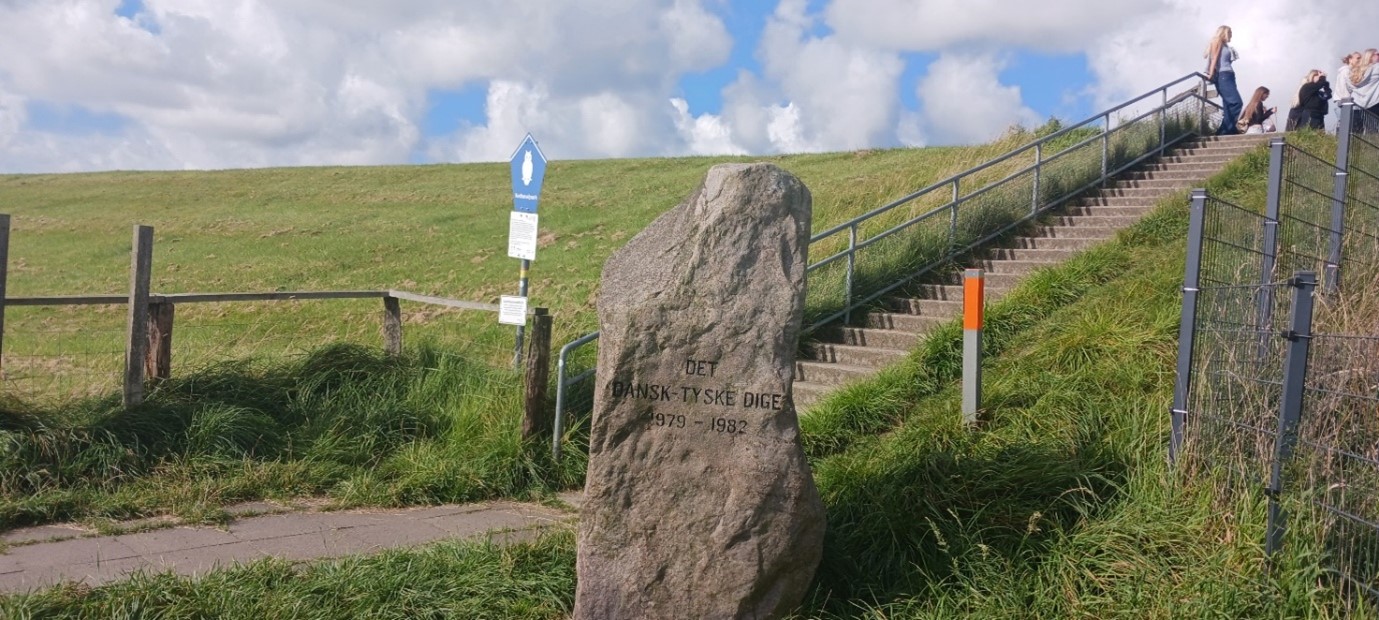In this article, the relation between borders and landscapes will be explained, as will the narrative composition of (border)landscapes. The methodology that we used in the B-Shapes project to shed light on ordinary people’s relations with the borderlandscapes where they live will additionally be presented.
Photo gallery
Bordering Landscapes
Landscapes are not just natural facts, but created through narratives, symbols and myths and thus formed by eyes that see, and stories told. We know this significance of landscapes from the world of art such as the Asian and European traditions of landscape painting. This is a form of painting where mountains and valleys, rivers and forests are subjects (fig. 1). Landscape paintings may be imaginary, or they may be aesthetic depictions of an existing reality, but they are per definition compositions and not just one-to-one depictions of nature.[1]

Yet, landscapes are more than objects of aesthetic performance. Landscape compositions are also shaped in and shaping most people’s understandings and perceptions of the natural environments they inhabit – also in border regions. Rather than seeing borders through an authoritative lens, the B-Shapes project has problematized borderlandscapes through the stories told by people living in those landscapes and the emotional attachment expressed in such border living.
When landscapes border
When we begin considering the constructed nature of landscapes, it can open towards reflections on relations between humans and nature. One of the most powerful of these has to do with the existence of state borders. State borders are, as we know, used to divide spaces, that is, carve out units in what would otherwise be integrated and connected spaces. We know this from the map of the world. Most state borders have been drawn at a desk and without consideration of the natural and human environments they supposedly divide. State borders thus colonize environments, thereby creating their own landscapes, such as the wilderness of bufferzones at the inner German iron curtain border, or the sharp and almost spectacular divide between urban and rural landscapes found on the US-Mexico border (fig. 2).
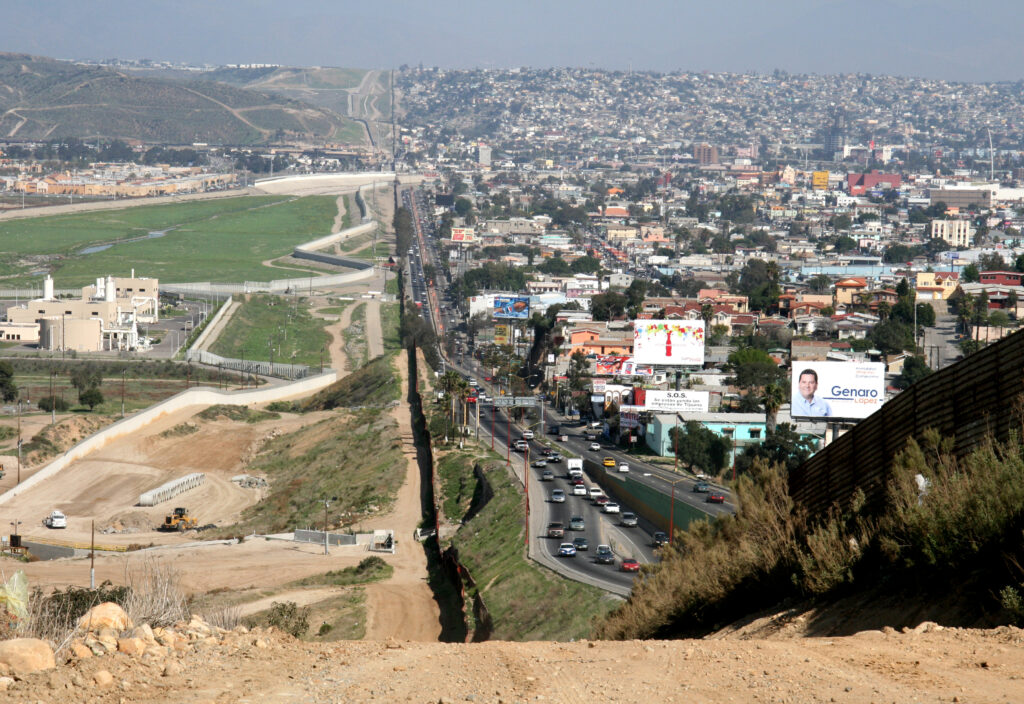
The act of carving out is thus inherent to the way we perceive geographical landscapes. Yet, when immediately thinking about the link between landscapes and borders, the function of mountain ranges and rivers as state borders naturally become center of attention. However, such natural environments do not lend themselves easily to the geometrical techniques of border drawing, also indicating the arbitrariness of thinking about state borders as naturally occurring. Whereas mountain ranges would make up extensive borderlands, rivers constantly change border-landscapes with their flow. None of these correspond to the landscape composed of the map with its linear and static borders. When these natural formations function as borders, this is also in the form of compositions, as is the case in aesthetic representation (see above).
Still, the symbolic significance of material found in the landscape, such as specific vegetation or animals has been inserted into geographical mappings of the world. Fauna is recognized as belonging to nations as national fauna (i.e., the Canadian Maple tree) and animals become national symbols, such as the Swedish Elg or the Greenlandic Ice Bear. In our current days, influenced by talk about climate change and environmental wounds, confinement of nature is formulated as one of ‘invasive species’, thus also indicating that fauna, vegetation and animal life belongs within the compartmentalized world of administratively drawn borders.
Border-landscapes are thus composed, tying natural habitat to the confines of states and the ownership of land. The ownership of land indicated by borders thereby creates a constitutive relation between natural environments and national, cultural heritage apparent. Monuments are placed to mark landscapes as heritage, thereby commemorating events and the actions of individuals and communities (fig. 3). This in turn illustrates how the landscape belongs to the very same individuals and communities that are often national.
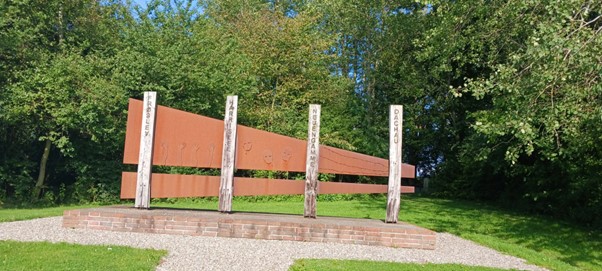
The perhaps most vivid illustration of the link between landscapes and state borders is represented in the material presence of monumental border architecture in the landscape. The more imposing reminders of state power in landscapes are the erections of walls and fences. They often cut through landscapes without taking into consideration the connections performed in the natural habitat. Trees and birds, deer and pigs do not border in the same way as humans do, and those architectures thereby override and colonize the performances of other beings in the natural habitat. In the Danish-German borderland there is even a fence targeted specifically at the movements of animals, the wild boar fence (fig. 4).

Border-landscaping narratives
Like other landscapes, border-landscapes are thus not just naturally there, but highly symbolic spaces, composed of material objects put in place by humans. Adding to this, landscapes are told in stories, narrated into being in collective imaginaries and memories told by generations, and in ordinary people’s stories about experiences they or their relatives have had in the landscapes. They can be oral, written in text or they can be told visually.
Such stories told about landscapes and constructing meaning around natural environments have often been both mythical and spiritual. The same is the case in the borderlands. National symbolism is known for combining nature, mythical figures and spirituality, for instance the use of the unicorn as the Scottish national animal. The borderland environment is thereby ascribed meaning in stories told, and thus also infested with a certain agency and autonomy. This inscription of agency to border-landscapes is especially significant in the imaginaries and memories of communities who are directly dependent on nature for their livelihood, such as seafarers and fishermen, for whom border-landscapes are watery worldly connections.[2]
Ordinary people learn to see and ascribe meaning to borderlandscapes through such narratives. As for borderlanders, they live in natural environments where state borders are not just lines on a map drawn on a desk. State borders are materially present and help compose the landscapes people live in. In the storytelling of borderlanders, borders drawn in the landscape therefore gain significance as integral elements to the stories people tell:
Participant 1: During the winter we are always out here with sledges, driven behind a tractor. Me and [mentions a friend by name] were sitting in the back of three sledges tied together and suddenly, my father in front of us, he just fell, and we couldn’t stop, so we just ran over him. It just said ”boom, boom” and then he lay there.
Participant 2: Yes, sometimes we just sled down the dike, but this year all the streets were frozen, and we could drive we the sledge on the streets… we had an old beer barrel, which we had cut the lid off and then you could put people into it. And there were five people in it and then we had a sled in the back… and we drove this tractor all the way.
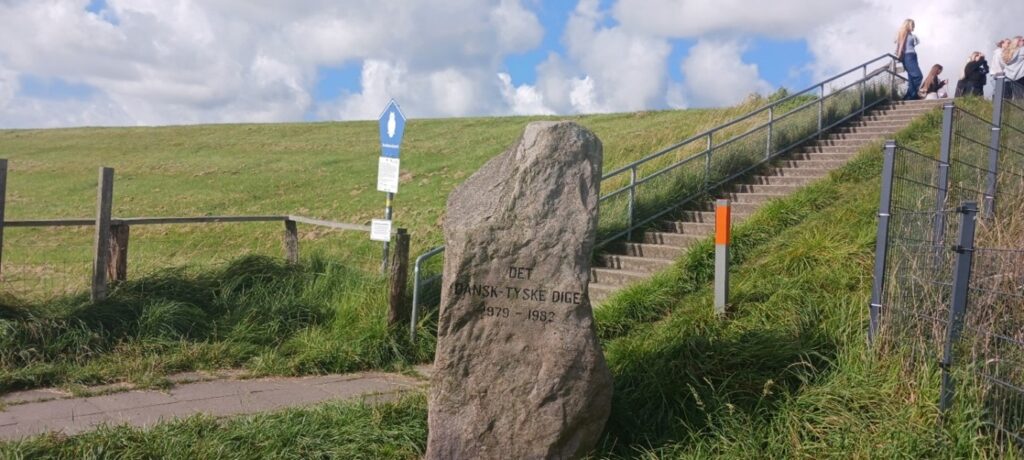
The fact that there is still no academic tradition for understanding borderlandscapes through narratives told by people living in borderlands illustrates the prevalence also in research of the previously described strict division established in modernity between human and nature and, accordingly, how underestimated the significance of landscapes is for our relation to borders.
Discovering the borderland narratives: B-shapes’ narrative methodology
To gain access to narratives about borderlandscapes, the B-shapes project used what would normally be called a ‘go-along’ method, or walking conversations.[3] This is to say that we walked with people living in borderlands and asked them to talk about places in the landscape. During the walks we thus visited what could be called “meaningful sites”, that is, places with a particular significance for the people we walked with. These meaningful sites could be officially recognized and connected with official narratives, such as monuments or specific buildings erected in the landscape. They could also build infrastructures, such as border control posts or fences. Yet, many times, they were ‘just’ natural environments such as rivers, fjords or lakes, or paths made by humans in these natural environments for specific purposes, such as the Border Guard Trail, an 84 km long hiking path previously used by Danish and German border guards to control the Eastern parts of the Danish-German border (fig. 6). As it says in tourism material promoting the hiking path:
As you follow the Border Guard Trail, it is not difficult to imagine how the border guard kept eyes and ears open as they walked their regular routes along the steep slopes, through the mysterious forests and along the flat beaches. Their task was to keep an eye out for smugglers who tried to bring goods into or out of the country without paying the customs duties that for centuries were one of Denmark’s most important sources of income.[4]
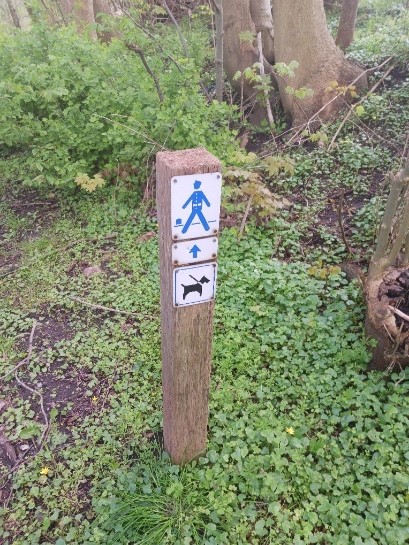
All sites visited were selected by the people we walked with. The sites chosen were connected by us into walking paths, possible to walk in about 1,5 hours and mostly including 4-5 sites. We asked the interlocutors to tell us about the chosen sites when we arrived at them, but we also had conversations while walking between sites, often also connected to the landscape we walked in. We used walking methods because of their ability to link people to the natural environment, as illustrated in this anecdote:
“There is a fence now but when I was a child, we were skating on the lake in the winter despite of it being German. At that time, the winters were harder than the ones we have now. We went down to the lake, and we were skating on half of it, because we believed half of it was ours.”[5]
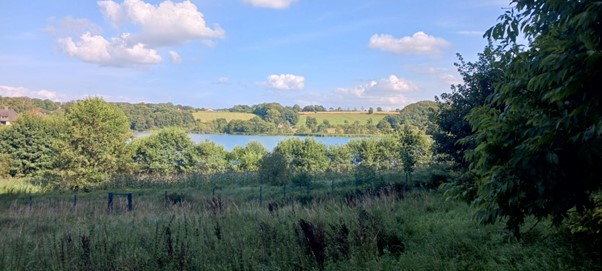
Generally, walking methods are used extensively in both human and social science because of being a valuable alternative to the more formal face-to-face interview. This has to do with how talking while walking creates a more informal setting than would be the case in traditional interviews conducted inside and while sitting down. Walking conversations are thus closer to everyday interactions. However, for the landscape dimension they are extra valuable because they take place in the natural environment. Being close to the sites, which are meaningful stir memories and make people tell stories based on those memories. Being there opens a level of imagination and conversation, which is otherwise not easily attained:
“Using such walking technique casts another light than is usually the case in literature and discourse on the question of where borders locate and matter, opening discussion of what the boundaries between individual and cultural memory are. Here the storytelling provides links between past and present, between memories and the contemporary realities of sites in the landscape, and thus between memories and material reality. Telling stories can thereby move people, transport and carry them away to distant places as they open the possibility for people to remember, but also to escape the common discourses dictating what one is supposed to talk about and what not.”[6]
So, as Jones et al. states about the walking method, it is “an ideal techniques for exposing issues around people’s relationship with space.”[7]
Attuning to the landscapes we live in
It is well known that narratives play an essential role when telling landscapes, yet it is less well known that narratives also play an essential role for the way people perceive the relation between landscapes and bordering processes. Moreover, most often when borderlandscapes are considered, it is with a focus on border architecture and the clear manifestations of state power, not on how people live with this presence. Yet:
“While walking and reading borderlandscapes [in the B-shapes project], we gained a more complex and nuanced picture than suggested in the literature. Personal and family histories, local tales and transnational relations are important for making sense of living in a borderlandscape. What we also learned is that local people’s stories of borderlandscapes as lived and inherited do not form a coherent narrative but instead offer polyphonic versions of borders.”[8]
Linking borders and landscapes through stories thereby attunes us to the complex relation between nature and human beings in concrete, materialized ways. Modernity has paid little attention to this relation, and if attention has been paid, it has often been romantic, not recognizing the complexities and tensions inserted in the relation. Understanding the symbolic and material significance of borderlandscapes asks us to reconsider the relation between nature and human beings. This may be a way to imagine the relation otherwise than that of the state border carving out spaces and confining natural environments, which often suffer because of it.
[1] See for instance Nils Büttner (2006) Landscape Painting: A History, translated by Russell Stockman. Abbeville Press.
[2] See Andersen, D.J., Opilowska. E. and Prokkola, E.-K., Nothing Quiet on the Eastern Front. In: Ali Mozaffari and David Harvey (ed), Border Straddling Heritages, Berghahn 2025.
[3] See for instance O’Neill, Maggie and Brian Roberts (2020) Walking Methods: Research on the Move. London: Routledge.
[4] Destination Sønderjylland, Gendarmstien, available at https://www.visitsonderjylland.dk/turist/oplevelser/aktiv-sammen/gendarmstien (last accessed 16.07.2025)
[5] Story narrated by an interlocutor during a borderwalk in the Danish-German borderland.
[6] Anguelova, Burtscher, Oberhofer (eds.) Through the Prism of Borders, Milano Kunstverlag 2025, 100-101.
[7] Jones P, Bunce G, Evans J, et al. (2008) Research design: exploring space and place with walking interviews. Journal of Research Practice 4(2): 1–9
[8] Anguelova, Burtscher, Oberhofer (eds.) Through the Prism of Borders, Milano Kunstverlag 2025, 98-99.



